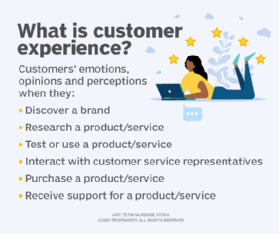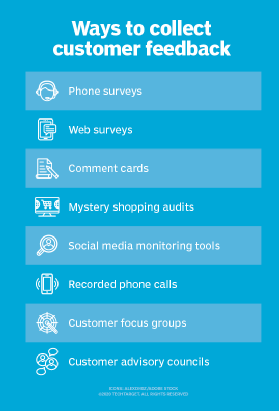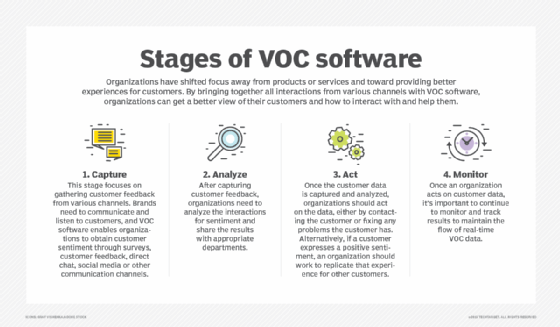
What is voice of the customer? A guide to VOC Strategy
Voice of the customer (VOC) is the component of customer experience (CX) that focuses on customer needs, wants, expectations and preferences. It's the process of collecting and analyzing customer feedback to improve the CX and overall business performance.
In most businesses, CX quality is a key differentiating factor among competitors. Deploying a VOC program is important for ensuring customer input is requested and valued.
To determine the VOC, an organization analyzes indirect input -- data that reflects customer behaviors -- and direct input -- data that reflects what a customer says. Gathering indirect input includes a close examination of monetary transactions, market research, product usage data and web analytics. Gathering direct input includes social media monitoring for brand or product mentions, collecting both negative and positive feedback from customers and conducting customer interviews.
Importance of voice of the customer
VOC is critical to understanding customer needs, improving customer satisfaction and driving business success. The following examines key reasons VOC is so significant:
Customer feedback helps organizations ensure they deliver features customers want and need. VOC data is customer feedback collected through surveys, user interviews, focus groups and customer data analysis.
VOC focuses on comprehending the VOC data rather than only gathering it. By listening to their consumers, businesses can improve their offerings and create something their target market values and continues to invest in with their time and money.
Customer retention and the ability to upsell are important revenue factors. VOC-enabled customer success is especially crucial to organizations with a pay-as-you-go pricing model, often delivered digitally in product offerings such as software as a service (SaaS).

It's important for businesses to inform their customers that their opinions matter and are being addressed. When VOC data drives changes in a company's strategies, products or services, there's an opportunity and need to communicate this to customers.
Businesses that lack a VOC strategy miss the chance to capitalize on satisfied customers and address the concerns of dissatisfied ones. Happy customers have the potential to create new business prospects while addressing the concerns of unsatisfied customers is crucial for reducing customer churn.
What are the benefits of voice of the customer?
VOC helps businesses listen to their customers and act on the information provided. Important VOC benefits include the following:
- Customer loyalty and retention. Businesses that pay close attention to customer feedback and act on it demonstrate a sincere interest in their customers' opinions and a desire to develop products and services that satisfy their demands. This, in turn, can boost customer retention and foster customer loyalty.
- Increased revenue. When businesses satisfy customer expectations by developing goods and services aligned to their preferences and needs, they're better positioned to increase their revenue and bottom line. Satisfied customers are more likely to refer others to the business.
- Better customer experience. A key objective of a VOC program is to enhance the CX at every stage of the customer's journey, from the initial interaction with the company to the point of purchase and beyond. Through VOC, businesses can gain valuable insights into their customers' desires and expectations, enabling them to make necessary adjustments to better cater to these needs.
- Improved products and services. Businesses that pay attention to client feedback can pinpoint the weak points in their products and services and make specific modifications to address these problems. This might result in improved goods and services that reflect what customers want.
VOC data collection methodologies
Businesses can collect direct feedback from customers and create a VOC program using one or more of the following methods:
- Customer advisory council. Businesses can organize a customer advisory council that meets with existing customers to gauge their feedback.
- Surveys and product reviews. Sending customers a request to complete surveys or product reviews is an effective way to gather valuable VOC data. Surveys and reviews can be sent to customers online, by phone or by mail. Surveys don't need to be long to have value. A few questions can be asked when a customer makes a transaction. Richer data can be mined from in-depth questionnaires, which are typically sent using email to highly engaged customers.
- Mystery shopping program. Creating a mystery shopping program in which customers complete audits and provide feedback on brand services, products and topics of periodic interest can help gather valuable VOC data. It helps brands gain insights into the customer's journey and identify areas for improvement.
- Net promoter score. NPS is a popular statistic for measuring customer loyalty that asks customers how likely they are to refer a company or product to someone else. Other scores, such as customer health score and customer effort score (CES), can, and ideally should, also be calculated.
- Social media. Social media listening involves using social media monitoring tools to monitor brand mentions on social media platforms. Valuable feedback can also be collected from popular forums, such as Reddit and Quora or anywhere customers share their views online.
- Live chat. Gathering live chat logs from customer support phone calls and text messages is a valuable way to capture and compile helpful VOC data.
- Focus groups. Similar to customer interviews, in-person focus groups can gather customer insights. Instead of being conducted one-on-one, focus groups involve a small group of customers who directly interact with the brand. These groups are particularly useful when seeking to understand how customers perceive a new product or when gauging their reactions to a rebranding or advertising campaign.
- Phone calls. Phone calls and phone call recordings can reveal a wealth of insight that goes beyond customers' simple preferences, as they also provide a glimpse into their emotions. In contrast, chatbots are limited in their ability to discern this level of information.
- Customer-facing employees. Team members who regularly interact with customers can provide valuable information about customer needs and expectations. The customer support team typically spends the most time communicating with customers and is often the first to identify customer pain points and issues that might be affecting multiple customers. The sales team is also an important source of information; it's responsible for understanding customer needs and matching them to the company's products or services.

Building a voice of the customer program
Executing VOC programs can increase customer loyalty and help companies create a more valuable product offering. Businesses should include all stakeholders and roles from across the company to provide input on what kind of customer feedback they seek. Some of these roles include chief information officers, chief customer officers, chief marketing officers, chief revenue officers and data analysts or scientists.
Once businesses establish a team and collect customer feedback, developing a strategy for using the data is next. The following are some best practices:
- Determine the target audience. To ensure the right customers are being targeted, companies carefully choose customer segments, buyer personas or specific demographics. Understanding key characteristics of the audience can influence the selection of the most effective feedback mechanisms and the most relevant methodologies.
- Identify core values. Discerning customers' relationships with the brand -- which might include shared values -- is essential to satisfying customer needs. CX teams must recognize these values in their clients to forge a deeper relationship.
- Select VOC tools carefully. VOC software is designed to analyze customer data and facilitate multichannel feedback. When choosing a VOC platform, organizations should consider its compatibility with existing customer relationship management systems and the quality of the analytics it provides. Different VOC tool vendors should be evaluated to determine the best fit.
- Analyze data to spot patterns and trends. Qualitative input can identify product bu2gs companies need to fix or customer service processes they need to improve. Quantitative data can identify high or low use rates in some features, indicating their usefulness or success.
- Share information across the organization. This is an important step, as different information benefits different business areas. It also communicates to employees how they're doing and what their customers expect.
- Act on customer insights from VOC data. Examples of actions include improving customer support and launching new products and services.
- Measure success. Customer satisfaction should be the core metric of an organization's analytics and always a brand's top priority. Once businesses identify and address an issue, they must follow up to gauge how customers respond to that change and whether it has the intended outcome.
- Make revisions. Customer ratings programs evolve, and it's desirable to make changes periodically to ensure that current feedback methodologies gauge customer satisfaction optimally. This could mean changing survey questions to gather new information or finding new ways to interact with customers.
Gathering customer feedback shouldn't be a one-and-done process. Businesses should conduct this exercise continuously throughout the customer journey.
Voice of the customer tools
VOC tools are software applications organizations can use to collect and analyze customer feedback to improve customer experience.

The following are examples of VOC tools and their main features:
- Alchemer. It automates the collection, integration and action on customer feedback and can integrate data from various applications.
- Clarabridge. This tool provides text and speech analytics to analyze customer interactions and feedback and ensure compliance with privacy mandates.
- Forsta. It handles large quantities of customer feedback and offers advanced analytics for in-depth data analysis.
- Medallia. It captures and analyzes customer engagement data from multiple applications to provide a holistic view of the customer journey.
- Qualtrics. A comprehensive platform tailored for various industries, offering integrations, structured and unstructured data analysis and customization options.
- QuestionPro serves small business owners. Its Community Management feature helps businesses manage panelists in an online community.
- SMG. The software offers a service model specializing in location-based services, such as stores, hotels and restaurants.
- SurveyMonkey. This tool collects feedback from various channels, including analytics tools and features that integrate deeply with Salesforce.
- Verint. The platform is used for data collection, integration and analysis across digital, physical and contact center databases. It focuses on speech analytics and predictive experience methodology.
Important VOC metrics
There are several important customer metrics related to VOC that organizations should track. The most important metrics include the following:
- Customer satisfaction score measures immediate customer reactions to specific interactions or product experiences.
- NPS evaluates customer loyalty based on how likely they are to recommend an organization's brand.
- CES tracks the ease or difficulty of customers' interactions with an organization's brand.
- Customer sentiment analysis analyzes the emotional tone of feedback to gauge customers' feelings toward an organization's product or service.
- Customer lifetime value (CLV) indicates the value a customer brings over their relationship with the brand.
- VOC feedback volume measures the quantity of feedback received.
- Customer retention measures the percentage of customers who stay with the brand.
Customer experience management platforms help organizations track customer journey touchpoints. Examine CXM platforms and their features. Learn about customer experience trends to know and see how to gather and evaluate customer sentiment.







